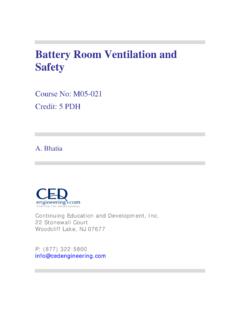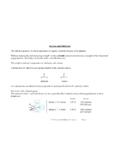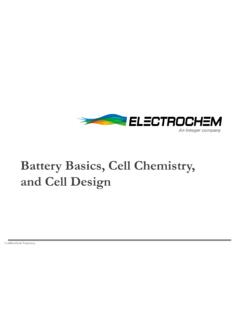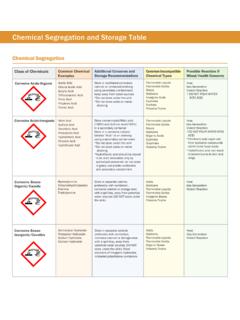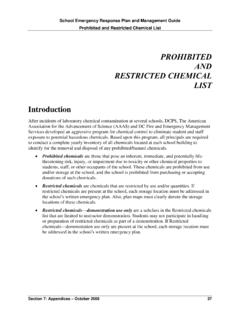Transcription of Spacecraft Power Systems - MIT OpenCourseWare
1 Spacecraft Power Systems David W. Miller John Keesee Electrical Power System EPS. Power Energy Power Power Regulation Source Storage Distribution and Control Power Sources Primary Batteries Radioisotope Secondary Battery Thermionic converter Fuel cell Thermoelectric converter Regenerative fuel cell Photovoltaic Chemical dynamic Solar dynamic Nuclear Flywheel Storage Electrodynamics Tethers Propulsion-charged tether Power Source Applicability 100. NUCLEAR THERMIONICS. SOLAR DYNAMIC AND. FUEL CELL PHOTOVOLTAIC. NUCLEAR. LOAD Power (kW). 10. CHEMICAL. DYNAMIC. (APUs) NUCLEAR THERMIONIC. OR SOLAR DYNAMIC. PHOTOVOLTAIC OR. 1 ISTOTOPE - THERMOELECTRIC. PRIMARY MONTHS YEARS. BATTERIES. 1 DAY 10 DAYS 1 2 3 6 12 2 4 6 810. 1 10 100 103 104 105. HOURS. Approximate ranges of application of different Power sources. Design Space for RTGs 107. 106. 105.
2 Electric - Power Level (kW). 100. % of Original Power Nuclear reactors 5-Year Design 104. Life 50. 103. 102. 0. 1 10 87. Years 101 Chemical The 87-year half-life of Pu-238 results in 96% of the original heat output even after five years 100. Solar Radioisotopes 10-1. 10 1 HOUR 1 DAY 1 MONTH 1 YEAR 10 YEARS. MIN. Duration of Use Primary Battery Types Silver zinc lithium sulfur lithium lithium dioxide carbon thionyl monofluoride chloride Energy density 130 220 210 275. (W h/kg). Energy density 360 300 320 340. (W h/dm3). Op Temp 0-40 -50 75 ? 82 -40 70. (deg C). Storage Temp 0 30 0 50 0 10 0 30. (deg C). Storage Life 30-90 days 10 yr 2 yr 5 yr wet, 5 yr dry Open circuit voltage(V/cell). Discharge voltage(V/cell). Manufacturers Eagle Pitcher, Honeywell, Eagle Pitcher Duracell, Yardley Power Conver Altus, ITT. Silver Zinc Cells Wide use in industry High energy density, high discharge rate capability, fast response Short lifetime Vent gas during discharge Potentially rechargeable but few cycles lithium cells Higher energy density than silver zinc Wide temperature range Low discharge rate (high internal impedance).
3 Rapid discharge may cause rupture Slow response Secondary Battery Types Silver zinc Nickel cadmium Nickel hydrogen Energy density 90 35 75. (W h/kg). Energy density 245 90 60. (W h/dm3). Oper Temp (deg C) 0 20 0 20 0 40. Storage Temp (C) 0 30 0 30 0 30. Dry Storage life 5 yr 5 yr 5 yr Wet Storage life 30 90 days 2 yr 2 yr Max cycle life 200 20,000 20,000. Open circuit (V/cell). Discharge (V/cell) Charge (V/cell) Manufacturers Eagle- Eagle-Pitcher, Eagle-Pitcher, Pitcher,Yardney Gates Aerospace Yardney, Gates, Technical Prod Batteries Hughes Nickel Cadmium Cells Long space heritage High cycle life, high specific energy Relatively simple charge control Systems Battery reconditioning necessary to counteract reduction in output voltage after 3000 cycles Nickel Hydrogen Cells Potentially longer life than NiCads Hydrogen gas negative electrode eliminates some failure modes Highly tolerant of high overcharge rates and reversal Individual, common and single pressure vessel types lithium Ion Cells Recently developed system, may provide distinct advantages over NiCd and NiH2.
4 Operating voltage is to v which reduces the number of cells 65% volume advantage and 50% mass advantage over state of the art Systems Depth of Discharge (Image removed due to copyright considerations.). Fuel Cells Load +. Cathode Anode H. 2e- 2e- Y O. D X. R Y. O. H2 2H+ 1/2 O2 G. G E. E N. N Electrolyte = H2O. 30% KOH. Waste water Fuel Cell Characteristics Output voltage per cell volts in practice Consumes hydrogen and oxygen, produces water as by-product (1 Pint/kW h). High specific Power (275 W/kg). Shuttle fuel cells produce 16 kW peak Reaction is reversible so regenerative fuel cells are possible Radioisotope Thermoelectric Generators Used in some interplanetary missions Natural decay of radioactive material provides high temperature source Temperature gradient between the p-n junction provides the electrical output High temperatures Lead telluride (300 500 deg C, silicon germanium >600 deg C.)
5 Excess heat must be removed from the Spacecraft (Dis) advantages of RTGs Advantages No moving parts or fluids, Do not require sunlight to operate conventional RTGs highly reliable. Long lasting and relatively insensitive RTGs are safe and flight-proven. to the chilling cold of space and They are designed to withstand any virtually invulnerable to high launch and re-entry accidents. radiation fields. RTGs are maintenance RTGs provide longer mission lifetimes than solar Power Systems . Disadvantages Supplied with RTGs, the Viking The nuclear decay process cannot be landers operated on Mars for four and six years, respectively. turned on and off. An RTG is active from the moment when the By comparison, the 1997 Mars Pathfinder Spacecraft , which used radioisotopes are inserted into the only solar and battery Power , assembly, and the Power output operated only three months.
6 Decreases exponentially with time. They are lightweight and compact. In An RTG must be cooled and shielded the kilowatt range, RTGs provide constantly. more Power for less mass (when The conversion efficiency is normally compared to solar arrays and only 5 %. batteries). Radioisotopes, and hence the RTGs themselves, are expensive Subsystem: Power (RTG). Modeling, Assumptions and Resources: RTG database 3 RTG types used for modeling General Purpose Heat Source (GPHS). Batteries Combinations of different types of RTGs Pow e r Source PBOL [We ] PEOL[We ] M as s [k g] Dim e ns ions [m ] Life [yrs ] Pu[k g] Cos t [M $] TRL Note s Cassini RTG 285 210 D = ,L= 8 9 18 GPHS. New MMRTG 140 123 32 D = ,L = 10 4 7 9 GPHS. SRG 114 94 27 D = ,L = 3 4 2 GPHS. <114 140 228 254 280 285 342 368 399 420 456 560 570 684 700. Watts 1 MMRTG. 3 MMRTG. 4 MMRTG. 5 MMRTG.
7 1 MMRTG. 2 MMRTG. 4 SRG. 1 MMRTG. 2 SRG. 3 SRG. or 5 SRG. 1 Cassini 1 Cassini 2 Cassini 1 SRG +. 6 SRG. 1 SRG. 2 SRG +. 1 SRG +. KKG. Subsystem: Power (RTG). Validation of model: Confirmation of data by multiple sources. Tested ranges of variables: Power required (< 0 to > kW). Hundreds of millions of $. Mission lifetime (< 0 to > sols). No discrepancies found. KKG. Thermoelectric Generator Heat Flow Thermal source Thot Electrical insulation Connecting straps - + - + - +. P N P N P N. + + - + - + - Thermal sink Tcold Electrical insulation Load Flywheel Energy Storage Modules (FESM) could replace batteries on Earth-orbit satellites. While in sunlit orbit, the motor will spin the flywheel to a fully charged speed generator mode will take over to discharge the flywheel and Power the satellite during the eclipse phase present flywheel technology is about four times better than present battery technology on a Power stored vs.
8 Weight comparison. Weighing less than 130 lbs, the FESM is in diameter by in length Delivers 2 kW-hr of useful energy for a typical 37- minute LEO eclipse cycle high speeds of up to 60,000 rpm the current average for commercial GSO storage is 2,400 lbs of batteries, which is decreased to 720 lbs with an equivalent FESM. Honeywell has developed an integrated flywheel energy storage and attitude control reaction wheel Energy stored in non-angular momentum change mode Solar Cell Long heritage, high reliability Power source High specific Power , low specific cost Elevated temperature reduce cell performance Radiation reduces performance and lifetime Most orbits will require energy storage Systems to accommodate eclipses Solar Cell Physics Covalent bond Photons - Electrons - - - n + - - +. - Holes + + + p Load +. +. +. - Flow of electrons Photons Si molecule Solar Cell Operating Characteristics Isc Maximum I-V curve Power point Imp P = constant Pmp Increasing Power Output current Area = maximum Power output e anc t esis r ad lo um it m Op Vmp Voc Solar Cell Operating Characteristics Pmp Output Power e rv Vmp cu V.
9 P- Output voltage Temperature Effects 160. 140. 120. CURRENT (mA). 1200C. 100 900. 600. 300. 80 00. -300. -600. -900. 60 -1200. -1500. -1700. 40. 20. 0 VOLTAGE (volts). Voltage - current characteristics vs cell temperature for 2 x 2 cm 10 ohm cm N/P solar cell Silicon thickness inch, active area cm2. Spectrosun solar simulator = AMO. Balloon calibration Radiation Effects 12 mil thick 100. RELATIVE OUTPUT (%). 90. 4 mil thick 80. 70. 60. 50. 40. 1013 1014 1015 1016 1017. FLUENCE, 1 Mev electrons/cm2. Alternate Solar Cell Technologies Cell type Silicon Thin sheet Gallium Indium Multijunction amorphous Si Arsenide Phosphide GaInP/GaAs Planar cell theoretical efficiency Achieved efficiency: Production 18% Best laboratory 10% Equivalent time in geosynchronous orbit for 15%. degradation 10 yr 10 yr 33 yr 155 yr 33 yr - 1 MeV electrons 4 yr 4 yr 6 yr 89 yr 6 yr - 10 McV electrons Solar Array Construction Construct arrays with cells in series to provide the required voltage Parallel strings provide required current Must plan for minimum performance requirements Radiation affects at end of life, eclipse seasons and warm cells Shadowing can cause cell hot spots and potentially cascading failure Cell Shadowing Affected portion of module with open or shadowed solar cell VA lA.
10 + A. +. Total cells VU. =sxp Total cells lU. +VBUS. = (s - 1) x p Affected Unaffected portion solar cell of module of s-1. cells in series . B l1. Cell Shadowing 4 Parallel Cells OP2. Q3. High Q4 Leakage Low CURRENT (A). (3 cells). 2 Parallel Cells OP1. Q1. Q2 High Leakage Low (one cell). 0 10 20 30 40 50. V. VBUS. Solar Array Construction Multi-layer blue Mg Fl AR coating reflecting filter Coverglass (0211 microsheet or Corning 7940 fused silica). SiO AR coating Glass/Cell Adhesive Solar Cell Solder Cell/Substrate Adhesive Fiberglass Insulator Substrate Aluminum Facesheet Facesheet/Core Adhesive Aluminum Honeycomb Core Facesheet/Core Adhesive Substrate Aluminum Facesheet Thermal Control Coating Power Supply-Demand Profiling Solar array: Silicon GaAs Multi junction Batteries: Secondary Battery Specific energy density (W-hr/kg). Nickel-Cadmium 25-35.











